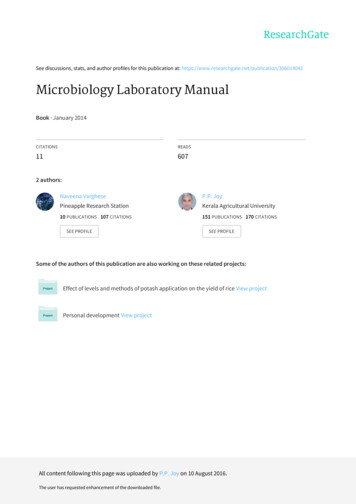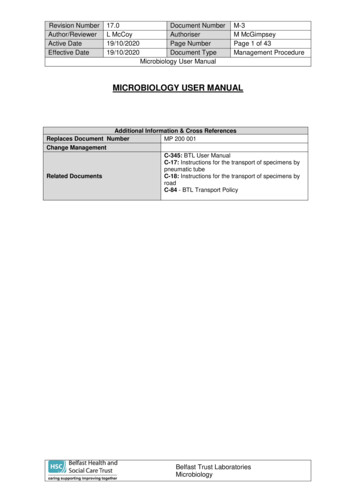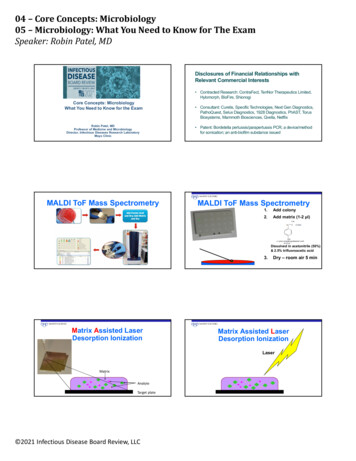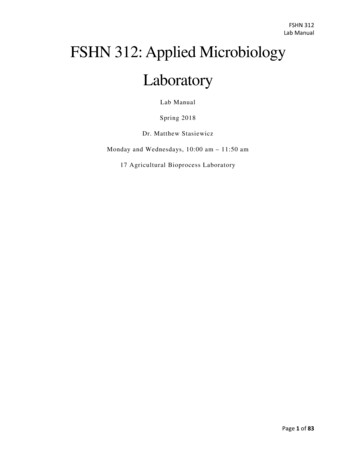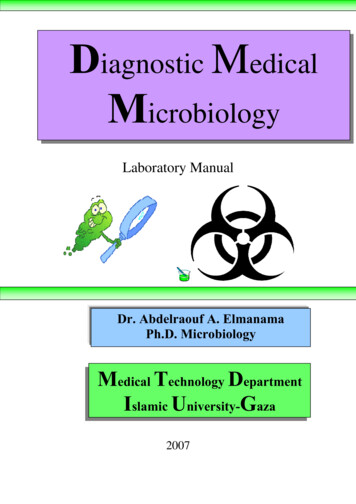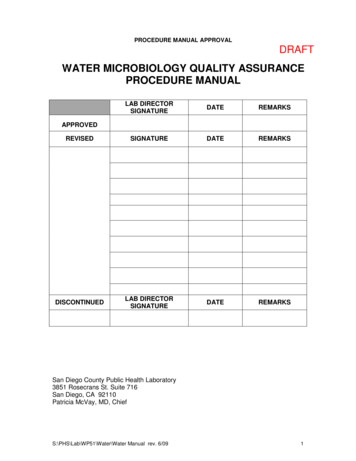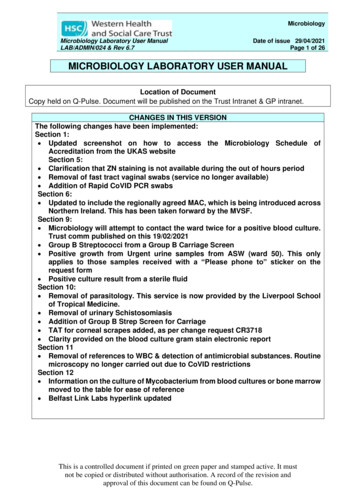
Transcription
MicrobiologyMicrobiology Laboratory User ManualLAB/ADMIN/024 & Rev 6.7Date of issue 29/04/2021Page 1 of 26MICROBIOLOGY LABORATORY USER MANUALLocation of DocumentCopy held on Q-Pulse. Document will be published on the Trust Intranet & GP intranet.CHANGES IN THIS VERSIONThe following changes have been implemented:Section 1: Updated screenshot on how to access the Microbiology Schedule ofAccreditation from the UKAS websiteSection 5: Clarification that ZN staining is not available during the out of hours period Removal of fast tract vaginal swabs (service no longer available) Addition of Rapid CoVID PCR swabsSection 6: Updated to include the regionally agreed MAC, which is being introduced acrossNorthern Ireland. This has been taken forward by the MVSF.Section 9: Microbiology will attempt to contact the ward twice for a positive blood culture.Trust comm published on this 19/02/2021 Group B Streptococci from a Group B Carriage Screen Positive growth from Urgent urine samples from ASW (ward 50). This onlyapplies to those samples received with a “Please phone to” sticker on therequest form Positive culture result from a sterile fluidSection 10: Removal of parasitology. This service is now provided by the Liverpool Schoolof Tropical Medicine. Removal of urinary Schistosomiasis Addition of Group B Strep Screen for Carriage TAT for corneal scrapes added, as per change request CR3718 Clarity provided on the blood culture gram stain electronic reportSection 11 Removal of references to WBC & detection of antimicrobial substances. Routinemicroscopy no longer carried out due to CoVID restrictionsSection 12 Information on the culture of Mycobacterium from blood cultures or bone marrowmoved to the table for ease of reference Belfast Link Labs hyperlink updatedThis is a controlled document if printed on green paper and stamped active. It mustnot be copied or distributed without authorisation. A record of the revision andapproval of this document can be found on Q-Pulse.
MicrobiologyDate of issue 29/04/2021Page 2 of 26Microbiology Laboratory User ManualLAB/ADMIN/024 & Rev 6.7ContentsPage1.INTRODUCTION . 32.LABORATORY CONTACT DETAILS . 53.OPENING HOURS . 64.AVAILABILITY OF CLINICAL ADVICE . 65.URGENT AND “OUT OF HOURS” SAMPLES . 66.THE REQUEST FORM . 77.COMMON REASONS FOR SAMPLES NOT BEING PROCESSED . 88.SAMPLE DELIVERY . 99.ELECTRONIC & TELEPHONED REPORT . 1010.SAMPLE CONTAINERS, TEST REPERTOIRE & TURNAROUNDTIMES . 1211.INTERPRETING LABORATORY RESULTS. 2212.SAMPLES REFERRED TO OTHER LABORATORIES . 2413.PROTECTION OF PERSONAL INFORMATION . 2614.LABORATORY COMPLAINT PROCEDURE . 2615.UNCERTAINTY OF MEASUREMENT (UoM) . 26LOOKING FOR SPECIFIC INFORMATION?Type the “test name” or a “keyword” in the text search box on the tool bar andpress enter- or use “Crtl F” keyboard shortcut if search box not displayedNOTE: IF PRINTED, ONLY VALID ON DAY OF PRINTINGThis is a controlled document if printed on green paper and stamped active. It mustnot be copied or distributed without authorisation. A record of the revision andapproval of this document can be found on Q-Pulse.
MicrobiologyMicrobiology Laboratory User ManualLAB/ADMIN/024 & Rev 6.7Date of issue 29/04/2021Page 3 of 261. INTRODUCTIONMicrobiology is an ISO15189 UKAS accredited laboratory.Medical LaboratoryNo. 8841Our accreditation is limited to those activities described on the UKAS scheduleof accreditation. This schedule can be accessed from the UKAS website. Usethe term “8841” to search for accredited organisations in the Who’s AccreditedtabThis is a controlled document if printed on green paper and stamped active. It mustnot be copied or distributed without authorisation. A record of the revision andapproval of this document can be found on Q-Pulse.
MicrobiologyMicrobiology Laboratory User ManualLAB/ADMIN/024 & Rev 6.7Date of issue 29/04/2021Page 4 of 26Microbiology is located within Altnagelvin Hospital, Laboratory/PharmacyBuilding, South Block, where it serves the whole of the Western Trust.Microbiology is directed by a Lead Consultant Clinical Microbiologist and ismanaged by a Lead Biomedical Scientist. The department offers a fulldiagnostic service to users in Hospital and primary care. Specialist tests arereferred to regional and supra-regional laboratories.The laboratory offers a comprehensive service, including a 24 hour emergencyservice. The department processes in excess of 230,000 samples each year.Microbiology follows Public Health England UK Standards for MicrobiologyInvestigations (SMIs) for processing and interpreting of clinical samples. TheSMIs are a comprehensive and referenced collection of recommendedalgorithms and procedures for clinical microbiology. Access to the standardmethods publications is via the PHE website Standards for microbiologyinvestigations (SMI) - GOV.UK Specimens for bacterial culture, wherever possible, should be collectedprior to commencement of antibiotic treatmentActual pus or tissue samples are always preferable to a swab.To avoid inadvertent contamination of a specimen during collection,aseptic non-touch technique must be used.Decontamination of the sampling site or equipment is necessary e.g. skinantisepsis before taking blood cultures or cerebrospinal fluids (CSF), orcatheter port antisepsis before collecting a specimen of urine via a catheter(CSU).Specimens must be collected into sterile containers with close fitting lids.The specimen must be clearly labelled (see Section 6 for labellingrequirements). Once collected, place the specimen into a plastic specimenbag and seal the bag. Wash your hands and dispose of clinical waste intoa yellow clinical waste collection bag. Sharps must be disposed of safely.Every clinical specimen sent for microbiology examination should betreated as potentially infectious. Standard precautions must be observedat all times.This is a controlled document if printed on green paper and stamped active. It mustnot be copied or distributed without authorisation. A record of the revision andapproval of this document can be found on Q-Pulse.
MicrobiologyDate of issue 29/04/2021Page 5 of 26Microbiology Laboratory User ManualLAB/ADMIN/024 & Rev 6.72. LABORATORY CONTACT DETAILSLABORATORY ADDRESSMicrobiologySouth WingAltnagelvin Area HospitalWestern Health & Social Care TrustGlenshane RoadBT47 6SBTELEPHONE DETAILSAltnagelvin Hospital Switchboard: (028) 71345171NameDr. G. GlynnConsultantMicrobiologistDr. C. ArmstrongConsultantMicrobiologistMartin RobinsonAnn MurrayMainMicrobiology LabMicrobiology oncall bleepMicrobiology oncall mobilenumberPosition/CommentsClinical Head ofServicesHead of LaboratoryLead BiomedicalScientistSecretary TB/Respiratory LabSterile Fluid RoomEnteric PathogensFor urgent out ofhours requestsFor urgent out ofhours requests.Users are advised tocontact switchboardin the first instanceContact detailsExt. 213776.If not available on this number, contact viatheir secretary or through switchboardExt. 213774If not available on this number, contact viatheir secretary or through switchboardExt. 213770Direct dial number: (028) 71296131Mobile: 07717 224973Martin.robinson@westerntrust.hscni.netExt. 213775Ann.murray@westerntrust.hscni.netExt. 214017Ext. 213767Ext. 213769Ext. 213764Ext. 213768Contact the Biomedical Scientist via theswitchboard07774 674191This is a controlled document if printed on green paper and stamped active. It mustnot be copied or distributed without authorisation. A record of the revision andapproval of this document can be found on Q-Pulse.
MicrobiologyMicrobiology Laboratory User ManualLAB/ADMIN/024 & Rev 6.7Date of issue 29/04/2021Page 6 of 263. OPENING HOURSMicrobiology offers a 24 hour service, 7 days a week, as detailed below: Monday to Friday- full service between 9.00am - 5.15 p.m. Saturdays, Sundays and Bank Holidays- a limited service between09.00am- 5.00 pm All other times (including Bank Holidays) a 24 hour emergency on-callservice is available.Urgent requests for Microbiology must always be arranged with the BiomedicalScientist. Please contact the department once the sample has been taken atone of the numbers detailed above or via the switchboard for samples takenoutside of the normal Laboratory opening hours.4. AVAILABILITY OF CLINICAL ADVICEMicrobiology offers a consultant led service. Please ensure you have discussedthe case/query with a senior colleague and have all relevant clinical informationto hand before contacting the Consultant Microbiologist for advice. For out-ofhours advice, contact the Consultant Microbiologist via the switchboard.5. URGENT AND “OUT OF HOURS” SAMPLESOnly certain tests are available as urgent requests, as listed below. Thelaboratory must be telephoned to arrange all urgent samples before thespecimen is sent to the laboratory. Failure to contact the laboratory will resultin the sample being processed as a routine sample. The requesting clinician isresponsible for arranging transport of urgent samples to the laboratory: CSF examination (microscopy & culture) Microscopy & culture of pus or body fluid from normally sterile sites Urine microscopy RSV Corneal scrapings Immediate plating and processing of samples where clinical managementcould be altered by the result. MRSA PCR- this is only available to a limited number of patients groups.Consultant Microbiologist approval is required. See WHSCT screeningMRSA policy for full details (this can be found on the Trust intranet site,under “Infection Prevention and Control Guidelines”). Rapid CoVID PCR swabs meeting the criteria set out in Section 10PLEASE NOTE: ZEIHL-NEELSEN STAINING IS NOT AVAILALBE DURINGTHE OUT OF HOURS PERIOD. THESE SAMPLES WILL BE PROCESSEDTHE NEXT DAYThis is a controlled document if printed on green paper and stamped active. It mustnot be copied or distributed without authorisation. A record of the revision andapproval of this document can be found on Q-Pulse.
MicrobiologyMicrobiology Laboratory User ManualLAB/ADMIN/024 & Rev 6.7Date of issue 29/04/2021Page 7 of 26PLEASE NOTE: THIS SERVICE IS FOR PROCESSING SAMPLES. IT ISNOT A RESULTS SERVICE6. THE REQUEST FORM/MINIMUM ACCEPTANE CRITERIA (MAC)ACCEPTABLE MINIMUM IDENTIFIERSThe following details are required on all request forms. Any requests missingthe mandatory information will not be processed Mandatory MAC MUST be present on ALL sample bottle/container andrequest form to assure sample acceptance for Laboratories and LIMS. Desirable MAC MUST be considered by the User as part of goodpatient management / ue identifier Number*Patient Official First NameSurnameSex (Male/Female/Other)Date of Birth (dd/mm/yyyy)Date and Time of Sample CollectionRequestor Name/CodeSource (Ward/Clinic /GP)Investigation (test) RequiredAnatomical site and specimen typeDesirable1. Relevant Clinical Information2. Current antibiotics and / or other relevantmedication3. Patient’s address, including postcode ifpossible4. Hazard Group 3 (Cat 3) Sticker if applicable(and approp. patient history)5. Printed name of sample collector6. MO signature7. Pregnancy status8. Contact number (bleep or extension) ofrequestor in the event of furthercommunication being required i.e. urgent testrequestSpecimen1.2.3.4.Unique identifier Number *Patient Official First NameSurnameDate of Birth (dd/mm/yyyy)1. Sex (Male/Female/Other)*The Health & Care Number must be used unless:a) The patient is not registered with a General Practitioner in NorthernIreland – use the local hospital numbering system.b) An emergency situation – use the local hospital EMERGENCYnumbering system.c) Other scenarios such as GUM and NSI (needle stick injury).Microbiology accepts that the unique identifier (H&C number) may not beavailable in all cases, e.g. temporary residents, cross border patients. If theH&C number is not available, this MUST be clearly stated on the request formor the request will not be processed. Use of the H&C number ensures there aresingle patient entries on the NIECR and laboratory system. This means allpatients’ results are stored in the one location. Multiple entries means it will takeThis is a controlled document if printed on green paper and stamped active. It mustnot be copied or distributed without authorisation. A record of the revision andapproval of this document can be found on Q-Pulse.
MicrobiologyMicrobiology Laboratory User ManualLAB/ADMIN/024 & Rev 6.7Date of issue 29/04/2021Page 8 of 26longer to find the correct result and poses significant risks for patients requiringblood transfusions.Specimens from patients known or suspected to be infected with a Category 3Pathogen, for example Mycobacterium tuberculosis, Hepatitis B virus, HIV orthe Enteric fevers must have a hazard warning HAZARD GROUP 3 label,affixed to both the specimen container and request form.The quality of the report you receive from Microbiology is dependent onthe quality of information received on the request form. Clinical detailsmake a difference on the types of organisms which are consideredsignificant. For example, coliforms in a wound swab would not beconsidered significant unless the patient is diabetic or the sample wasfrom a surgical wound. Without this information the final report will be“No significant growth”. A patient with recurring/persistent sore throatmay have an infection caused by an anaerobe which would not be lookedfor without the clinical details. Audits have shown that 45% of samplesreceived in the department have no clinical details stated on the requestforms.7. COMMON REASONS FOR SAMPLES NOT BEING PROCESSED No H&C number on sample and request formUnlabelled specimensSpecimen mismatch (patient details on specimen don’t match those onrequest form)Specimens without a test requestIncomplete or illegible request formsSpecimens received in a non-sterile containerLeaking specimensTissue/specimens received in formalin or any other fixativeContaminated specimens or request formsSwabs with no site statedInsufficient urine in a boric acid containerUrine received in a non-boric acid container which has been taken 4hours before receipt in the lab and no evidence of refrigerationBlood cultures which have been refrigeratedSamples for MRSA PCR which do not meet the acceptance criteria, e.g.no ward stated, previous history not indicated on the request formThis is a controlled document if printed on green paper and stamped active. It mustnot be copied or distributed without authorisation. A record of the revision andapproval of this document can be found on Q-Pulse.
MicrobiologyMicrobiology Laboratory User ManualLAB/ADMIN/024 & Rev 6.7Date of issue 29/04/2021Page 9 of 268. SAMPLE DELIVERYALTNAGELVIN HOSPITALSpecimens are transported by the Portering Service or the Vacuum TransferSystem to the Laboratory/ Laboratory Reception. The Laboratory must becontacted regarding all urgent requests.The address number for the Vacuum Transfer System (VTS) intoMicrobiology is 850. It is the responsibility of the sender to ensuresamples are forwarded to the correct address. Sending a pod to adifferent address will result in a delay in the sample getting toMicrobiology. Samples of tissue/bone/CSF & other non-repeatablesample should NOT be sent via the pneumatic tube.Several specimens have been sent to the laboratory via the VTS to thelaboratories from patients with/suspected HAZARD GROUP 3 pathogenssuch as HIV, hepatitis B and hepatitis C & CoVID. These samples posepotentially significant risks to the health of the laboratory staff handlingthe specimens. These samples should NEVER be sent via the VTS. Suchsamples should always be transported to the laboratories inside sealed,approved transport bags.NOTE: The use of brown envelopes for transporting laboratory samplesfrom ward/outpatients is prohibited and must not be used.SOUTH WEST ACUTE HOSPITALEach week day (Monday – Friday), a van leaves the SWAH, Enniskillen at8:50am, calls at Tyrone County Hospital, Omagh at 10:00am and arrives atAltnagelvin Area Hospital at approximately 11:30–12 midday. A secondtransport run is provided leaving SWAH at 2:00pm, calling at Tyrone CountyHospital at 2:45pm to arrive in Altnagelvin Area Hospital at 4:00pm. Specimensare collected at these times and brought to Altnagelvin. Laboratory reports aredelivered on the return journey.On Saturday, Sunday and Bank Holidays, specimens are collected from SWAHat 10:00am and delivered to Altnagelvin Area Hospital by approximately 12:00midday.Urgent specimens which arrive outside the normal collection times aretransported to Altnagelvin Area Hospital via taxi service. This is organised bythe requestor who must also inform the Microbiology Laboratory in Altnagelvinthat an urgent specimen has been sent.This is a controlled document if printed on green paper and stamped active. It mustnot be copied or distributed without authorisation. A record of the revision andapproval of this document can be found on Q-Pulse.
MicrobiologyMicrobiology Laboratory User ManualLAB/ADMIN/024 & Rev 6.7Date of issue 29/04/2021Page 10 of 26SAMPLES FROM OUTPATIENTS AND GP SURGERIESPickup and delivery times are detailed in [SPECREC/47]. This policy isavailable on request. Please contact the department to request a copy of thispolicy.9. ELECTRONIC & TELEPHONED REPORTMicrobiology endeavours to report results electronically as soon as the resultsare available. In order to facilitate the department in producing prompt reports,it is requested that phone calls made to the department are for urgent resultsonly. Please check for the result on the labs system prior to any phone call.Microbiology reports cell counts for urine directs, fluids & CSF sampleselectronically. These will be available within 1 hour of the sample beingreceived within the department. The Gram stain following a positive bloodculture is also reported electronically.Listed below are the organisms which the department will phone out to therequestor: Positive blood cultures- gram stain, followed by preliminary culture andsensitivity results. Microbiology will attempt to contact the ward twice with apositive, as per the Trust communication, dated 18/02/2021 Urgent CSF samples- microscopy result will only be phoned if there is anelevated white cell count or organisms present in the Gram stain. There willonly be another phone call if there is a positive growth. MRSA- 1st isolate from all sites, for hospital inpatients. ESβL’s- 1st isolate from all sites, except urine, for hospital inpatients. VRE/GRE- 1st isolate from all sites, for hospital inpatients. CPE- 1st isolate from all sites, for hospital and community patients. Group A Streptococci- from wound swabs, ulcers, soft tissue sites, forhospital and community patients. Group B Streptococci- Neonatal patients and vaginal swabs from patientswith ruptured membranes, in labour ward/delivery suite Group B Streptococci from a Group B Carriage Screen Chlamydia/gonorrhoeae PCR- positive samples only TB- ZN stain, PCR and/or culture positive samples only Positive Legionella urinary antigen Faecal isolates from hospital inpatients. Positive C. difficile toxins positiveisolates will be phoned to a nursing home (if clearly identified on the requestform). Positive growth from Urgent urine samples from ASW (ward 50). This onlyapplies to those samples received with a “Please phone to” sticker on therequest form Positive culture result from a sterile fluidThis is a controlled document if printed on green paper and stamped active. It mustnot be copied or distributed without authorisation. A record of the revision andapproval of this document can be found on Q-Pulse.
MicrobiologyMicrobiology Laboratory User ManualLAB/ADMIN/024 & Rev 6.7Date of issue 29/04/2021Page 11 of 26Please note: Microbiology receives around 700 samples per day. If you requirea result urgently, it is important to contact the laboratory prior to sending thesample. Contact the lab if you require a result to be phoned back on a samplewhich is not listed above.Audits in Microbiology have shown that up to 20% of requests into thedepartment have no ward stated on either the request form or sample.Microbiology endeavours to locate these patients in order to alert theward to a positive result. However, by not including the ward on therequest form there will be a delay in this report. On rare occasions it maynot be possible to locate the patient, resulting in the message not beingrelayed back to the ward.This is a controlled document if printed on green paper and stamped active. It mustnot be copied or distributed without authorisation. A record of the revision andapproval of this document can be found on Q-Pulse.
MicrobiologyMicrobiology Laboratory User ManualLAB/ADMIN/024 & Rev 6.7Date of issue 29/04/2021Page 12 of 2610. SAMPLE CONTAINERS, TEST REPERTOIRE & TURNAROUND TIMESSterile universal containers Small volume of urineTAT 3 daysThe preferred container for urine microbiology is theboric acid container (see below). This containershould only be used for small volumes. Please note:this MUST reach the lab within 4 hours of productionto ensure there is no overgrowth of skin flora. Thesample can be refrigerated prior to sending to the lab.Please indicate this on the request form. CSF examinationNote: Glucose, protein and xanthrochromia are testedin Biochemistry.Normal CSF values.Leucocytes Neonates 28 0-30 cells X 106/LdaysInfants1-12 0-15 cells X 106/LmonthsChildren/Adults 0-5 cells X 106/L1year Erythrocytes No RBCs should be present innormal CSFPlease note: These values represent theapproximate upper and lower limits ofnormality and are for guidance only. Urgent cellcounttelephonedonce available.Culturenegativeresults 3 daysPositiveresultspreliminaryresulttelephoned tothe ward.Electronicreport 5 daysOther sterile fluids, for example joint fluid, Microscopy/cellcount phonedpleural fluid, ascetic fluid, peritoneal fluidAny sample received for O&S will be cultured and havea gram stain performed. If you require a cell count,please state “cell count & O S” on the request form.Any request which states cell count only will not becultured. Cell counts for sterile fluids are reported asnumber of cells X 106/L (displayed as 10 6/L)on the sameday if thesample isurgent. Culturenegativeresults 5days.Positive cultureresults: wardcontactedCorneal scrapes received as a blade in Brain HeartInfusion broth.Very small volumes of aqueous and vitreous taps,where the volume is too low to be received in aUniversal container, may be sent in a syringe. Note: theneedle should not be sent Microbiology with the syringe12 daysThis is a controlled document if printed on green paper and stamped active. It mustnot be copied or distributed without authorisation. A record of the revision andapproval of this document can be found on Q-Pulse.
MicrobiologyMicrobiology Laboratory User ManualLAB/ADMIN/024 & Rev 6.7 Date of issue 29/04/2021Page 13 of 26PusPus is preferable to a swab if available. Microscopyand culture carried out routinely.Extended incubation may be required for somesamples Culture results 5daysLegionella and Pneumococcal urinaryantigensAcceptance criteria are in place for Legionellaurinary antigen testing. This test will only beperformed when specific clinical details areincluded on the request formFor pneumococcal urinary antigen, a CURB-65score of 2 must be clearly stated on the requestform1 day. Pleasenote: thesetests are notavailable at theweekend O&S- 4 daysTB- Positive ZNstains will bephoned to theward.AAFB cultureresults cantake up to 7weeks. Positiveresults will bephoned whenavailableBAL samplesMicroscopy and culture performed on all samples. TBmicroscopy and culture performed on request only.Indicate the region of the lung the sample has beentaken from if more than 1 sample is being sent. Formultiple samples, if there is no indication of region ofthe lung, only 1 sample with be processed.Universal container with boric acidTAT 3 days 30ml universal container for urine samplesBoric acid is added to these containers as apreservative. Boric acid has been shown to kill anybacteria present in the urine if the concentration is toohigh.Please fill to the indicated line. Containers with insufficient urine added willnot be processed If the patient can only produce a smallvolume of urine, please use the white topsterile universal container (see above)Urinary catheters will not be processed.This is a controlled document if printed on green paper and stamped active. It mustnot be copied or distributed without authorisation. A record of the revision andapproval of this document can be found on Q-Pulse.
MicrobiologyMicrobiology Laboratory User ManualLAB/ADMIN/024 & Rev 6.7Date of issue 29/04/2021Page 14 of 26Early morning urine container Urine- for TB culture only.PHE standards indicate that microscopy for AAFB inthis sample can be misleading due to the presence ofnon-tuberculous mycobacteria. Microscopy is notperformed on these samples.Samples should be sent on 3 consecutive days.Please ensure the full early morning urine sample issent.Samples received in a sterile universal container willNOT be processedTATAAFB cultureresults cantake up to 7weeks. Positiveresults will bephoned whenavailableMRSA PCR testingCopan swabs for MRSA PCR testing 1 dayFor urgentMRSA PCR is only offered to a limited number of usersand only available for nasal swabs. In the vast majority tests, the resultis availableof cases, screening by culture is recommended. Seewithin 90WHSCT screening MRSA policy for full details (this canminutesofbe found on the Trust intranet site, under “InfectionreceiptofthePrevention and Control Guidelines”).sampleThis is a controlled document if printed on green paper and stamped active. It mustnot be copied or distributed without authorisation. A record of the revision andapproval of this document can be found on Q-Pulse.
MicrobiologyMicrobiology Laboratory User ManualLAB/ADMIN/024 & Rev 6.7Date of issue 29/04/2021Page 15 of 26Universal container with spoonContainer to be used for faecal samples only. O&SThe lab routinely tests for the following pathogens:Salmonella, Shigella, Campylobacter & E. coli 0157.Patients 16 years also get a stain for Cryptosporidium C. diffTAT 3 days30 hoursMicrobiology has a two- step testing algorithm for Cdifficile toxin detection. This involves the moleculardetection of C. diffiilce toxin B gene by nucleic acidextraction/purification. For any sample testing positivefor the toxin B gene, confirmation of presence orabsence of the toxin is undertaken by immunoassay.Minimum of 5mL of sample required. Only liquidsamples will be tested (5, 6 or 7 on the Bristol StoolChart) on the following patients:- Patients 65 years- Patients on stated antibiotics- On requestPatients 2 years will not be tested.Send separate samples if requesting C. diff & O&S. Rotavirus & AdenovirusFor patients aged 5 yearsStudies have shown that after the first injection of thevaccine, shedding of rotavirus antigens can occurafter 2-14 days post vaccination. If stool samples arecollected 15 days after vaccination, the vaccinationshould not interfere with the diagnostic Rotavirus andtherefore only patients infected with the virus will bedetected 3 daysPositive rotaand/or Adenophoned to thewardParasitologySamples are forwarded to a PHE reference lab inLiverpoolFor investigation of thread worms, a dry cotton swab isrequired. Samples are best obtained in the morningbefore bathing. Rub a moistened swab over the areaaround the anus, but do not insert into the anus. Placethe swab in a sterile in a universal container and sendto the lab (do not place the swab in transport media).This is a controlled document if printed on green paper and stamped active. It mustnot be copied or distributed without authorisation. A record of the revision andapproval of this document can be found on Q-Pulse.
MicrobiologyMicrobiology Laboratory User ManualLAB/ADMIN/024 & Rev 6.7Date of issue 29/04/2021Page 16 of 26Wide mouthed universal container SputumSalivary samples have been shown to be of little valuein the diagnosis of URTI. These samples will not beprocessed.AAFB microscopy and culture performed on request Tissue/bonePlease note: consider blood cultures as an aid in thediagnosis of osteomyelitisExtended incubation is required for these samples IUCDThese should only be sent for culture if there are clinicalindications of PID or other inflammatory conditions.Culture for Actinomyces spp. takes a minimum of 10days TATO&S 3 daysTB- PositiveZN stains willbe phoned tothe ward.AAFB cultureresults cantake up to 7weeks.Positiveresults will bephoned whenavailableWritten/electronicreport 5-10days 10 daysIntravascular cannulaeDefinitive diagnosis of CR-BSI can only be achieved byculturing the cannulae. Only send the terminal 4 cm ofthe cannulae.Alternatives to the catheter tip are blood cultures orswabs of the insertion site.DO NOT send urinary catheters- these will not beprocessed. 3 daysThis is a controlled document if printed on green paper and stamped active. It mustnot be copied or distributed without authorisation
Microbiology Microbiology Laboratory User Manual Date of issue 29/04/2021 LAB/ADMIN/024 & Rev 6.7 Page 1 of 26 This is a controlled document if printed on green paper and stamped active. It must not be copied or distributed without authorisation. A record of the revisi

